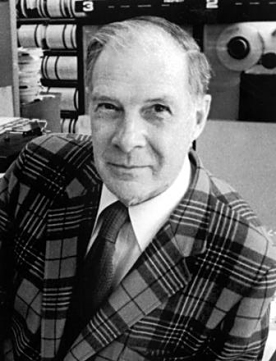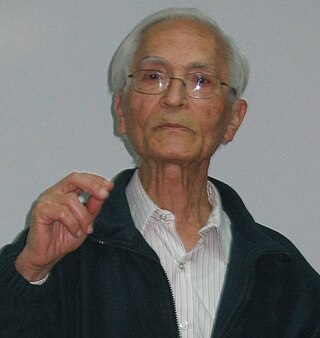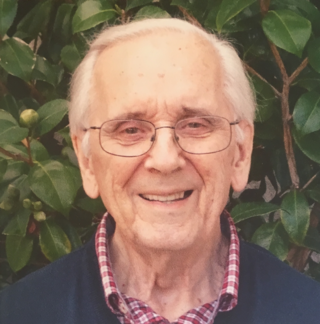Related Research Articles

Richard Wesley Hamming was an American mathematician whose work had many implications for computer engineering and telecommunications. His contributions include the Hamming code, the Hamming window, Hamming numbers, sphere-packing, Hamming graph concepts, and the Hamming distance.

Coding theory is the study of the properties of codes and their respective fitness for specific applications. Codes are used for data compression, cryptography, error detection and correction, data transmission and data storage. Codes are studied by various scientific disciplines—such as information theory, electrical engineering, mathematics, linguistics, and computer science—for the purpose of designing efficient and reliable data transmission methods. This typically involves the removal of redundancy and the correction or detection of errors in the transmitted data.
Run-length limited or RLL coding is a line coding technique that is used to send arbitrary data over a communications channel with bandwidth limits. RLL codes are defined by four main parameters: m, n, d, k. The first two, m/n, refer to the rate of the code, while the remaining two specify the minimal d and maximal k number of zeroes between consecutive ones. This is used in both telecommunication and storage systems that move a medium past a fixed recording head.
In computer data storage, partial-response maximum-likelihood (PRML) is a method for recovering the digital data from the weak analog read-back signal picked up by the head of a magnetic disk drive or tape drive. PRML was introduced to recover data more reliably or at a greater areal-density than earlier simpler schemes such as peak-detection. These advances are important because most of the digital data in the world is stored using magnetic storage on hard disk or tape drives.

Kornelis Antonie "Kees" Schouhamer Immink is a Dutch engineer, inventor, and entrepreneur, who pioneered and advanced the era of digital audio, video, and data recording, including popular digital media such as compact disc (CD), DVD and Blu-ray disc. He has been a prolific and influential engineer, who holds more than 1100 U.S. and international patents. A large portion of the commonly used audio and video playback and recording devices use technologies based on his work. His contributions to coding systems assisted the digital video and audio revolution, by enabling reliable data storage at information densities previously unattainable.

Abraham Lempel was an Israeli computer scientist and one of the fathers of the LZ family of lossless data compression algorithms.
Hierarchical storage management (HSM), also known as Tiered storage, is a data storage and Data management technique that automatically moves data between high-cost and low-cost storage media. HSM systems exist because high-speed storage devices, such as solid state drive arrays, are more expensive than slower devices, such as hard disk drives, optical discs and magnetic tape drives. While it would be ideal to have all data available on high-speed devices all the time, this is prohibitively expensive for many organizations. Instead, HSM systems store the bulk of the enterprise's data on slower devices, and then copy data to faster disk drives when needed. The HSM system monitors the way data is used and makes best guesses as to which data can safely be moved to slower devices and which data should stay on the fast devices.

Jacob Ziv was an Israeli electrical engineer and information theorist who developed the LZ family of lossless data compression algorithms alongside Abraham Lempel.
Richard E. Blahut, former chair of the Electrical and Computer Engineering Department at the University of Illinois at Urbana–Champaign, is best known for his work in information theory. He received his PhD Electrical Engineering from Cornell University in 1972.
Gottfried Ungerboeck is an Austrian communications engineer.

Michael George Luby is a mathematician and computer scientist, CEO of BitRipple, senior research scientist at the International Computer Science Institute (ICSI), former VP Technology at Qualcomm, co-founder and former chief technology officer of Digital Fountain. In coding theory he is known for leading the invention of the Tornado codes and the LT codes. In cryptography he is known for his contributions showing that any one-way function can be used as the basis for private cryptography, and for his analysis, in collaboration with Charles Rackoff, of the Feistel cipher construction. His distributed algorithm to find a maximal independent set in a computer network has also been influential.
Edward Joseph McCluskey was a professor at Stanford University. He was a pioneer in the field of Electrical Engineering.
The IEEE Emanuel R. Piore Award was a Technical Field Award given each year by the IEEE to an individual or team of two people who have made outstanding contributions to information processing systems in relation to computer science. The award was discontinued in 2012.
Jorma Johannes Rissanen was an information theorist, known for originating the minimum description length (MDL) principle and practical approaches to arithmetic coding for lossless data compression. His work inspired the development of the theory of stochastic chains with memory of variable length.

Hisashi Kobayashi was the Sherman Fairchild University Professor of Electrical Engineering and Computer Science, emeritus at Princeton University in Princeton, New Jersey. His fields of expertise included applied probability; queueing theory; system modeling and performance analysis; digital communication and networks; network architecture; investigation of the Riemann hypothesis; and stochastic modeling of an infectious disease. He was a Senior Distinguished Researcher at the National Institute of Information and Communications Technology (NICT), Japan from September 2008 to March 2016.

John Mathew Cioffi is an American electrical engineer, educator and inventor who has made contributions in telecommunication system theory, specifically in coding theory and information theory. Best known as "the father of DSL," Cioffi's pioneering research was instrumental in making digital subscriber line (DSL) technology practical and has led to over 400 publications and more than 100 pending or issued patents, many of which are licensed.
David Albert Huffman was an American pioneer in computer science, known for his Huffman coding. He was also one of the pioneers in the field of mathematical origami.

Charles Denis Mee was a British-American engineer, physicist, and author who was noted for his contributions in the areas of magnetic recording and data storage on hard disk drives (HDD). A large part of his career was with IBM in San Jose California. He is the author or editor of several books on magnetic recording.

Robert E Fontana is an engineer, physicist, and author who is noted for his contributions in the areas of magnetic recording and data storage on hard disk drives (HDD) and on digital tape recorders. His work has concentrated on developing thin film processing techniques for nano-fabrication of magnetic devices including Giant Magnetoresistance read heads now used universally in magnetic recording. Much of his career was with IBM in San Jose, California. He is a Fellow of the Institute of Electrical and Electronics Engineers and a member of the National Academy of Engineering.
Albert Smiley Hoagland had a long career on the development of hard disk drives (HDD) starting with the IBM RAMAC. From 1956 to 1984, he was with IBM in San Jose, California, and then, from 1984 to 2005, he was the director of the Institute for Information Storage Technology at Santa Clara University. He wrote the first book on Digital Magnetic Recording. Hoagland played a central role in the preservation and restoration of the IBM RAMAC now displayed at the Computer History Museum, Mountain View, California. He died in Portland, Oregon, on 1 October 2022.
References
- ↑ Peter Franaszek at the Mathematics Genealogy Project
- 1 2 3 IEEE Richard W. Hamming Medal Recipients , an IEEE webpage (retrieved October 1, 2010)
- ↑ "IEEE Emanuel R. Piore Award Recipients" (PDF). IEEE. Archived from the original (PDF) on November 24, 2010. Retrieved March 20, 2021.
- ↑ "IBM receives three IEEE awards", IBM Research News, July 6, 2009 (retrieved October 1, 2010)
- ↑ "IEEE Richard W. Hamming Medal Recipients" (PDF). IEEE . Retrieved May 29, 2011.